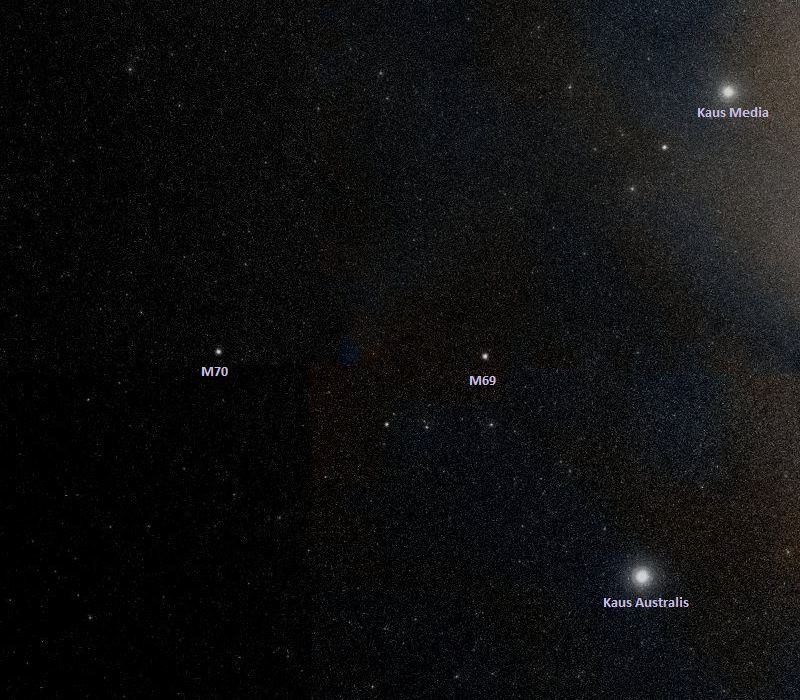Welcome back to Messier Monday! Today, we continue in our tribute to our dear friend, Tammy Plotner, by looking at the globular cluster known as Messier 69.
In the 18th century, while searching the night sky for comets, French astronomer Charles Messier kept noting the presence of fixed, diffuse objects he initially mistook for comets. In time, he would come to compile a list of approximately 100 of these objects, hoping to prevent other astronomers from making the same mistake. This list – known as the
Messier Catalog
– would go on to become one of the most influential catalogs of Deep Sky Objects.
One of these objects is known as Messier 69 (NGC 6637), a globular cluster located in the
constellation Sagittarius
. Located about about 29,700 light-years away from Earth, this cluster lies close to Messier 70 (both of which were discovered Charles Messier on August 31st, 1780). Both objects lie close to the galactic center, and M69 is one of the most metal-rich globular clusters known.
Description:
At about 29,700 light years from Earth, this 61 light year diameter ball of stars is one of the faintest of the Messier objects and very close to our galactic center. It was formed quite early in our galactic history and is one of the most metal rich of all globular clusters. As Robert Zinn and Pierre DeMarque of Yale University's Department of Astronomy wrote in a
1996 study
:
[caption id="attachment_139180" align="aligncenter" width="573"]
This dazzling image shows the globular cluster Messier 69, as viewed through the NASA/ESA Hubble Space Telescope. Credit: NASA/ESA/HST
[/caption]
One very odd thing about M69 is its lack of variable stars. Harlow Shapley didn't find any and the number of known variable stars debatable, with a few of them being Mira-type variable stars with periods of about 200 days. As J.D. Gregorsok (et al) indicated in a
2003 study
:
Are studies like this important? You bet. Because neighboring globular cluster M70 is so close in distance, there's a distinct chance the two might be physical neighbors. Only through studies can we understand if they truly formed together or not. As A. Rosenberg (et al) explained in a
2000 study
:
[caption id="attachment_139179" align="aligncenter" width="580"]
The Messier 69 globular cluster, as imaged by the Hubble Space Telescope. Credit: NASA/ESA/Hubble Space Telescope
[/caption]
History of Observation:
M69 was discovered by Charles Messier and added to his catalog on August 31, 1780, the same night he found M70. In his notes he states: "Nebula without star, in Sagittarius, below his left arm and near the arc; near it is a star of 9th magnitude; its light is very faint, one can only see it under good weather, and the least light employed to illuminate the micrometer wires makes it disappear: its position has been determined from Epsilon Sagittarii: this nebula has been observed by M. de La Caille, and reported in his Catalog; it resembles the nucleus of a small Comet. (diam 2')".
While Messier was mistaken about LaCaille's position, there was no mistaking the observations of Sir William Herschel who first resolved this globular cluster - from a very northern position! "1784, 20 feet telescope. Very bright, pretty large, easily resolvable, or rather an already resolved cluster of minute stars. It is a miniature of the 53d of the Connoissance [M53]." His son John would go on to add it to the General Catalog and describe it as a "blaze of stars", while Messier's error would continue on for many years as a debate on LaCaille's position.
But you know where to find it!
Locating Messier 69:
Because the constellation of Sagittarius is so low for the northern hemisphere, it is best to wait until it is at culmination (its highest point) before trying for this small globular cluster. Begin by identifying the familiar teapot asterism and draw a mental line between its southernmost stars - Zeta and Epsilon. About one third the distant between Epsilon and Zeta, you will see a conspicuous pair of stars that will show easily in your binoculars or telescope finderscope. M69 is less than a degree north of the northernmost of this pair.
[caption id="attachment_139181" align="aligncenter" width="471"]
The location of Messier 69 in the Sagittarius constellation. Credit: IAU and Sky & Telescope magazine (Roger Sinnott & Rick Fienberg)
[/caption]
In binoculars, M69 will appear almost stellar and very faint - like a hairy star that won't quite resolve. To a small telescope it will appear cometary and begin resolution in apertures around 8". It requires dark, transparent skies and is not well suited to moonlight or urban lighting situations.
And here are the quick facts on this Messier Object to help you get started:
- Object Name
-
Messier 69
- Alternative Designations
-
M69, NGC 6637
- Object Type
-
Class V Globular Cluster
- Constellation
-
Sagittarius
- Right Ascension
-
18 : 31.4 (h:m)
- Declination
-
-32 : 21 (deg:m)
- Distance
-
29.7 (kly)
- Visual Brightness
-
7.6 (mag)
- Apparent Dimension
-
9.8 (arc min)
We have written many interesting articles about Messier Objects here at Universe Today. Here's Tammy Plotner's
Introduction to the Messier Objects
,
M1 – The Crab Nebula
, and David Dickison's articles on the
2013
and
2014
Messier Marathons.
Be to sure to check out our complete
Messier Catalog
. And for more information, check out the
SEDS Messier Database
.
Sources:
- *Messier Objects - Messier 69*
- *SEDS - Messier 69*
- NASA - Messier 69
- Wikipedia - Messier 69
 Universe Today
Universe Today
